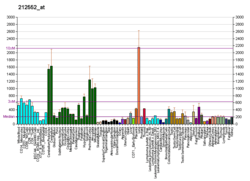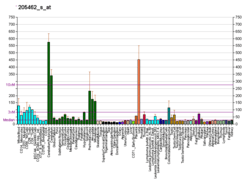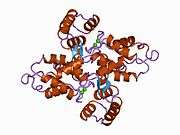References
- 1 2 3 GRCh38: Ensembl release 89: ENSG00000115756 - Ensembl, May 2017
- 1 2 3 GRCm38: Ensembl release 89: ENSMUSG00000071379 - Ensembl, May 2017
- ↑ "Human PubMed Reference:".
- ↑ "Mouse PubMed Reference:".
- ↑ Kobayashi M, Takamatsu K, Fujishiro M, Saitoh S, Noguchi T (Aug 1994). "Molecular cloning of a novel calcium-binding protein structurally related to hippocalcin from human brain and chromosomal mapping of its gene". Biochim Biophys Acta. 1222 (3): 515–8. doi:10.1016/0167-4889(94)90062-0. PMID 8038222.
- ↑ Oikawa K, Kimura S, Aoki N, Atsuta Y, Takiyama Y, Nagato T, Yanai M, Kobayashi H, Sato K, Sasajima T, Tateno M (Apr 2004). "Neuronal calcium sensor protein visinin-like protein-3 interacts with microsomal cytochrome b5 in a Ca2+-dependent manner". J Biol Chem. 279 (15): 15142–52. doi:10.1074/jbc.M312766200. PMID 14739275.
- 1 2 "Entrez Gene: HPCAL1 hippocalcin-like 1".
- ↑ Burgoyne RD (2007). "Neuronal Calcium Sensor Proteins: Generating Diversity in Neuronal Ca2+ Signalling". Nat. Rev. Neurosci. 8 (3): 182–193. doi:10.1038/nrn2093. PMC 1887812. PMID 17311005.
Further reading
- Hidaka H, Okazaki K (1993). "Neurocalcin family: a novel calcium-binding protein abundant in bovine central nervous system". Neurosci. Res. 16 (2): 73–7. doi:10.1016/0168-0102(93)90074-Z. PMID 8387172.
- Andersson B, Wentland MA, Ricafrente JY, et al. (1996). "A "double adaptor" method for improved shotgun library construction". Anal. Biochem. 236 (1): 107–13. doi:10.1006/abio.1996.0138. PMID 8619474.
- Yu W, Andersson B, Worley KC, et al. (1997). "Large-Scale Concatenation cDNA Sequencing". Genome Res. 7 (4): 353–8. doi:10.1101/gr.7.4.353. PMC 139146. PMID 9110174.
- Spilker C, Richter K, Smalla KH, et al. (2000). "The neuronal EF-hand calcium-binding protein visinin-like protein-3 is expressed in cerebellar Purkinje cells and shows a calcium-dependent membrane association". Neuroscience. 96 (1): 121–9. doi:10.1016/S0306-4522(99)00536-9. PMID 10683417.
- Bernstein HG, Baumann B, Danos P, et al. (2000). "Regional and cellular distribution of neural visinin-like protein immunoreactivities (VILIP-1 and VILIP-3) in human brain". J. Neurocytol. 28 (8): 655–62. doi:10.1023/A:1007056731551. PMID 10851344.
- Hartley JL, Temple GF, Brasch MA (2001). "DNA Cloning Using In Vitro Site-Specific Recombination". Genome Res. 10 (11): 1788–95. doi:10.1101/gr.143000. PMC 310948. PMID 11076863.
- Braunewell K, Riederer P, Spilker C, et al. (2001). "Abnormal localization of two neuronal calcium sensor proteins, visinin-like proteins (vilips)-1 and -3, in neocortical brain areas of Alzheimer disease patients". Dementia and Geriatric Cognitive Disorders. 12 (2): 110–6. doi:10.1159/000051244. PMID 11173883.
- Ivings L, Pennington SR, Jenkins R, et al. (2002). "Identification of Ca2+-dependent binding partners for the neuronal calcium sensor protein neurocalcin delta: interaction with actin, clathrin and tubulin". Biochem. J. 363 (Pt 3): 599–608. doi:10.1042/0264-6021:3630599. PMC 1222513. PMID 11964161.
- Spilker C, Gundelfinger ED, Braunewell KH (2002). "Evidence for different functional properties of the neuronal calcium sensor proteins VILIP-1 and VILIP-3: from subcellular localization to cellular function". Biochim. Biophys. Acta. 1600 (1–2): 118–27. doi:10.1016/s1570-9639(02)00452-1. PMID 12445467.
- Strausberg RL, Feingold EA, Grouse LH, et al. (2003). "Generation and initial analysis of more than 15,000 full-length human and mouse cDNA sequences". Proc. Natl. Acad. Sci. U.S.A. 99 (26): 16899–903. doi:10.1073/pnas.242603899. PMC 139241. PMID 12477932.
- Pribanic S, Loffing J, Madjdpour C, et al. (2004). "Expression of visinin-like protein-3 in mouse kidney". Nephron Physiology. 95 (4): 76–82. doi:10.1159/000074844. PMID 14694264.
- Gerhard DS, Wagner L, Feingold EA, et al. (2004). "The Status, Quality, and Expansion of the NIH Full-Length cDNA Project: The Mammalian Gene Collection (MGC)". Genome Res. 14 (10B): 2121–7. doi:10.1101/gr.2596504. PMC 528928. PMID 15489334.
- Wiemann S, Arlt D, Huber W, et al. (2004). "From ORFeome to Biology: A Functional Genomics Pipeline". Genome Res. 14 (10B): 2136–44. doi:10.1101/gr.2576704. PMC 528930. PMID 15489336.
- Rual JF, Venkatesan K, Hao T, et al. (2005). "Towards a proteome-scale map of the human protein-protein interaction network". Nature. 437 (7062): 1173–8. doi:10.1038/nature04209. PMID 16189514.
- Mehrle A, Rosenfelder H, Schupp I, et al. (2006). "The LIFEdb database in 2006". Nucleic Acids Res. 34 (Database issue): D415–8. doi:10.1093/nar/gkj139. PMC 1347501. PMID 16381901.
- Jheng FF, Wang L, Lee L, Chang LS (2007). "Functional contribution of Ca2+ and Mg2+ to the intermolecular interaction of visinin-like proteins". Protein J. 25 (4): 250–6. doi:10.1007/s10930-006-9008-5. PMID 16703469.
- Lim J, Hao T, Shaw C, et al. (2006). "A protein-protein interaction network for human inherited ataxias and disorders of Purkinje cell degeneration". Cell. 125 (4): 801–14. doi:10.1016/j.cell.2006.03.032. PMID 16713569.
PDB gallery |
|---|
1bjf: CRYSTAL STRUCTURE OF RECOMBINANT BOVINE NEUROCALCIN DELTA AT 2.4 ANGSTROMS |







